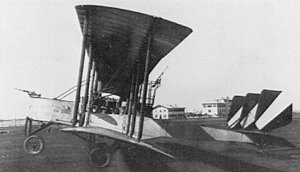Caproni Ca.3
|
|
The Caproni Ca.3 was an Italian heavy bomber of the World War I and post-war era. It was the definitive version of the series of aircraft that began with the Caproni Ca.1 in 1914.
| Contents |
Development
The development of the Ca.1 through the Ca.2 continually suggested the benefits of ever-increasing amounts of power to the very sound airframe. The Ca.3 built on the Ca.2 by also replacing the two engines mounted on the booms with the same Isotta-Fraschini engine that had been used as the central, pusher engine on that design. The prototype flew in late 1916 and it was soon put into production. Known to Caproni at the time as the Caproni 450 hp, the Italian Army designated it the Ca.3, and in Caproni's post-war redesignation, it became the Ca.33. Somewhere between 250 and 300 of these aircraft were built, supplying the Italian Army and Navy (the latter using the type as a torpedo bomber) and the French Army. Late in the war, Robert Esnault-Pelterie built the type under licence in France, building an additional 83 (some sources say only 19) aircraft.
Note: there is some variation in published sources over early Caproni designations. The confusion stems, in part, from three separate schemes used to designate these aircraft - Caproni's in-house designations of the time, those used by the Italian Army, and designations created after the war by Caproni to refer to past designs.
Service history
The Ca.1 entered service with the Italian Army in Summer of 1915 and first saw action on August 20 1915, attacking the Austrian air base at Aisovizza. Fifteen bomber squadrons (1-15 Squadriglia) were eventually equipped with Ca.1, Ca.2, and Ca.3 bombers, mostly bombing targets in Austro-Hungary. The 12th squadron operated in Libya. In 1918 three squadrons (3, 14 and 15) operated in France.
Apart from the Italian Army, Caproni Ca.3s were also used in British squadrons, before introducing of Handley Page Type O bombers. Original and licence-built ones were used by France (original Caproni were used in French CAP escadres, licence built examples in CEP escadres). They were also used by the US Expedionary Force.
Some of the Ca.36Ms supplied after the war were still in service to see action in Mussolini's first assaults on North Africa.
Variants
All of the following designations were applied after the war. At the time, all were known as the 300 hp by Caproni and the Ca.3 by the Army.
- Ca.34 and Ca.35 with modified central nacelle to seat the two pilots in tandem and therefore improve aerodynamics. No production.
- Ca.36 with removable outer wing panels for ease of storage.
- Ca.36M or Ca.36 mod (for modificato - "modified") - a lightened and simplified variant put into production after the war. 153 were delivered between 1923 and 1927, 144 of them to the new Regia Aeronautica.
- Ca.36S - air ambulance version (small number converted from Ca.36Ms)
- Ca.37 - prototype single-engined two-seat ground attack aircraft
- Ca.39 - seaplane version. No production
- Ca.56a - airliners created by remanufacturing war-surplus Ca.3s
Description:
Three-engine biplane of a wooden construction, covered with fabric. Crew: 4 in an open central nacelle (front gunner, two pilots and rear gunner-mechanic). The rear gunner manned upper machine guns, standing upon the central engine in a protective "cage", just before a propeller. Tricycle landing gear.
Armament: 2 to 4 Revelli 6.5mm or 7.7mm machine guns: 1 in front ring mounting and 1, 2 or sometimes even 3 in an upper ring mounting. Bombs suspended under the hull.
References
- Aircraft of the AEF - Caproni Ca.3 (http://www.worldwar1.com/dbc/caproni3.htm)
- Aerei Italiani (http://www.aerei-italiani.net/SchedeT/aereoca2.htm) (Italian)
Specifications (Ca.36)
General Characteristics
- Crew: four, two pilots, front gunner, and rear gunner-mechanic
- Length: 11.05 m (36 ft 3 in)
- Wingspan: 22.74 m (74 ft 7 in)
- Height: 3.70 m (12 ft 2 in)
- Wing area: 95.6 m² (1,029 ft²)
- Empty: 2,300 kg (5,060 lb)
- Loaded: kg ( lb)
- Maximum takeoff: 3,800 kg (8,360 lb)
- Powerplant: 3x Isotta Fraschini V.4B, 112 kW (150 hp) each
Performance
- Maximum speed: 137 km/h (86 mph)
- Range: 599 km (374 miles)
- Service ceiling: 4,844 m (15,892 ft)
- Rate of climb: 126 m/min (413 ft/min)
- Wing loading: kg/m² ( lb/ft²)
- Power/Mass: kW/kg ( hp/lb)
Armament
- 2x 6.5 mm or 7.7 mm Revelli machine guns
- 800 kg (1,760 lb) of bombs
Related content
Related development: Ca.1 - Ca.2 - Ca.5
Comparable aircraft:
Designation sequence: Ca.1 - Ca.2 - Ca.3 - Ca.4 - Ca.5
|
Lists of Aircraft | Aircraft manufacturers | Aircraft engines | Aircraft engine manufacturers Airports | Airlines | Air forces | Aircraft weapons | Missiles | Timeline of aviation |

